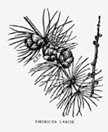AMERICAN LARCH
tamarack, hackmatack
Larix laricina (Du Roi) Koch
|
| American larch is a forest tree of the swamps. In the mountainous sections of the state, it is frequently found well up the slopes, but is confined to cold swamps in eastern, central, and western New York. The wood is very heavy, hard, and strong, light brown in color, and durable in contact with the soil. It is used for fence posts, telegraph poles, and railroad ties. |
| Bark - smooth, light gray in color on young trunks; with age becoming roughened with thin reddish brown scales.Twigs - slender, smooth, glossy brown in color, with short lateral wart-like branches. Winter buds - scattered along last season's twigs and at the ends of short lateral branches, small, rounded, reddish brown in color, shining. Leaves - borne singly on twigs of last season's growth; on spurs of older twigs in clusters of 10 or more, flat, slender, pale green in color, about 1 inch long, falling off in the autumn of the first year. Fruit - a cone, 1/2 inch long, borne on short curving stalks, maturing in autumn of the first year, chestnut brown in color, standing upright from the twigs, staying on the tree for several years. Cone scales - concave in shape. Seeds - in pairs, winged, light brown in color, 1/8 inch long, ripening in early autumn. Distinguishing features - many needles in cluster, dropping in autumn; small stiff cone on incurved stalk. 28a. European larch (Larix decidua Miller), which is one of several species that are difficult to distinguish, has been planted for many years on lawns and more recently in forest plantations. It has infrequently naturalized. Its cones are 1 to 1 1/2 inches long, standing out from the twig. It grows on well-drained soils much more rapidly than the American larch. |

No comments:
Post a Comment